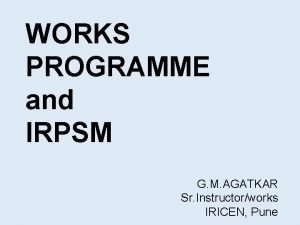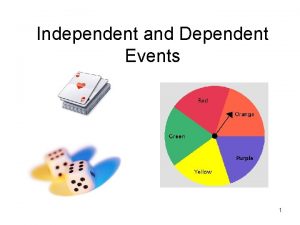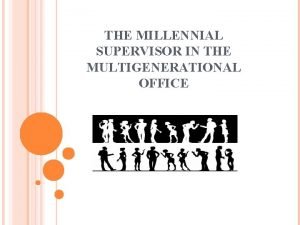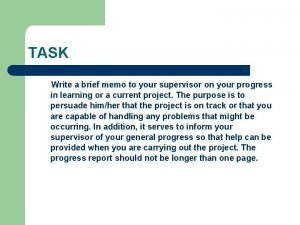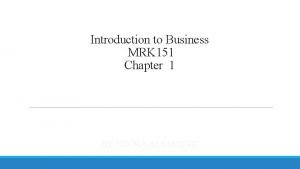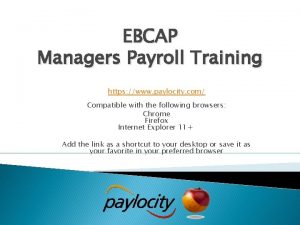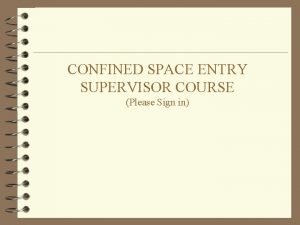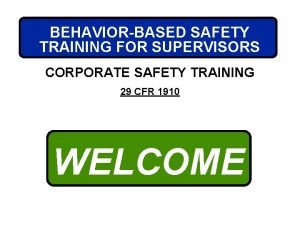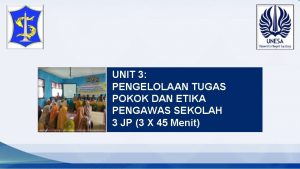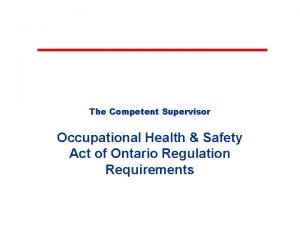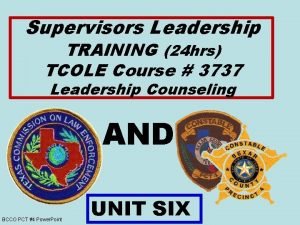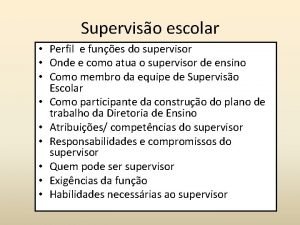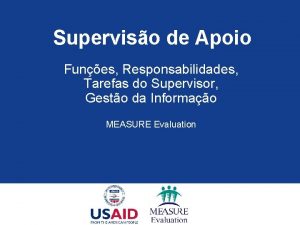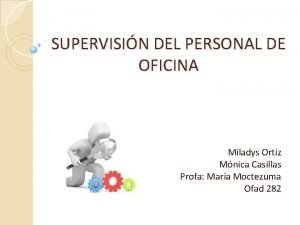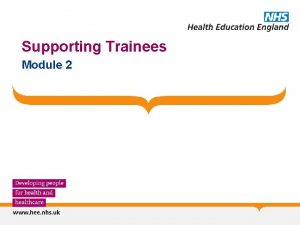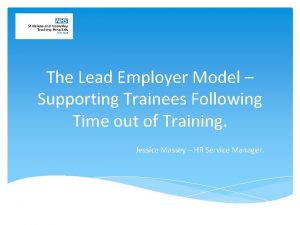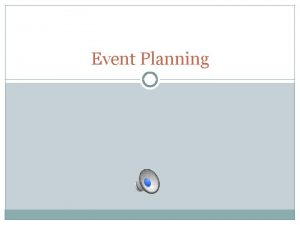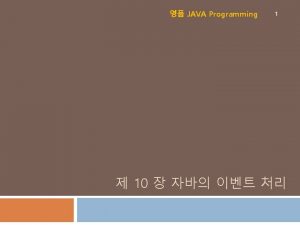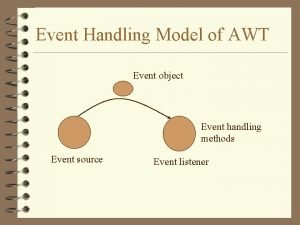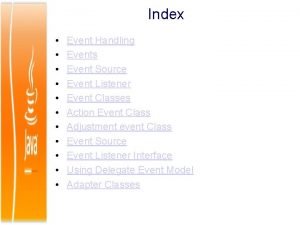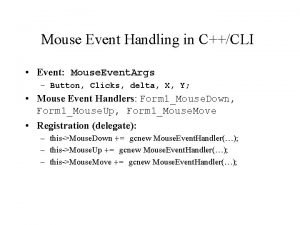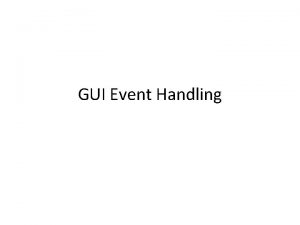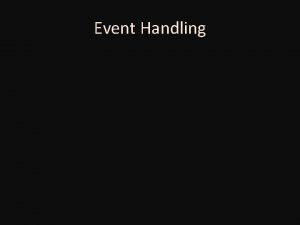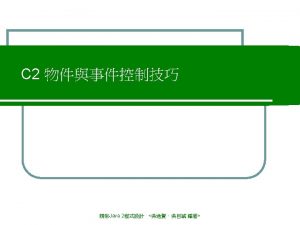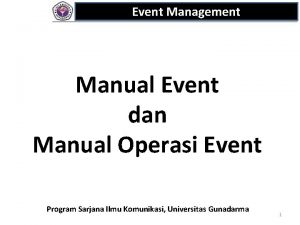PWP Supervisor Event supporting trainees in service March





































- Slides: 37

PWP Supervisor Event ‘supporting trainees in service’ March 2019

Agenda • Welcome • The PWP role and supervision • Layout of the course • Assessment of trainee competency • Course assessment • Your role in assessing the trainee • Challenges in supervising a trainee PWP • Q & A

Welcome • General Housekeeping • • Toilets Mobile phones Fire exits Refreshments • Introductions

Importance of supervision in the training year • Supervising a PWP trainee does involve a lot of work both in terms of your role as an educator but also associated paperwork and assessment, so thanks for taking on this role • PWP Trainee role is a demanding and vital role for the provision of IAPT EXERCISE Think back to your training year. Think about a time where you had a helpful supervision experience (CMS or clinical) and the impact this had on you as a trainee. Think about an experience of unhelpful supervision and the impact of this on you as a trainee. Discuss in pairs.

Supervision quotes • “it's like always having someone on your side and it helps because you don't ever feel like you're facing difficult situations on your own - you always have backup” • “I often felt out of my depth when working with patients in my trainee year, but having a supportive supervisor was invaluable - she really helped me cope…my supervisor helped me to learn from mistakes rather than dwell on them” • “For me good supervision enables you to step back from the complexity of cases and other pressures and develop your understanding of your role as a PWP. What you are expected to do, and what you are not expected to do. What you should focus on with patients and what you should avoid. What outcome you are seeking and what you are not. It helps you stay true to the model”

Service variation • There is huge variation between service structure and procedures throughout the region • Assessment structure, use of 5 areas, problem statements • We deliver a standardised curriculum which includes the core aspects of the role • Difficulties can arise for trainees where there is conflict between what is taught and service expectations and the reality of clinical practice Q) How could you as a supervisors help your trainee/s to manage this conflict?

Overview of the Sheffield PWP course • February 2019 – February 2020 • Teaching typically runs February – November • Module 1: Low Intensity Psychological Interventions for Mental Health • Part 1 A: Engagement and assessment of patients with common mental health problems • Part 1 B: Evidence based low intensity treatment for common mental health problems • Module 2: The Social and Healthcare Context (Values, Diversity & Context)

How the trainees are assessed • Assessment OSCE plus reflective essay (2000 words) • Treatment tape – Any intervention taught as part of this course plus reflective essay (2000 words) • Formative telephone screening • Case Management Process Analysis (2000 words) • Diversity Case Study (2500 words) • Portfolio

Competency assessment on the course • Assessment OSCE -First milestone for trainees • Treatment Tape • 6 supervisor rated session • • • 1 x assessment session 1 x worry management 1 x problem solving 1 x exposure 1 x cognitive restructuring 1 x behavioural activation • Preparation in service – role play, practice, shadowing, live supervision, tapes • Using the competency framework (grid handouts) • Pass mark 18 or above, need to score 3 or above in each section – absence of risk assessment automatic fail • Example tape to mark today • Manual (handout)

Treatment tape (video) • • Submission date – 10 th July Must be real patient – sign off sheet required University provide a practice tape session –tutor and peer feedback Trainees need to score ‘ 3’ in change method Absence of risk assessment is automatic fail Pass is 18 or over Support this in service, eg. , access to equipment and appropriate patients Reflective essay (2000 words)

The importance of competency • There are crucial reasons for assessing and ensuring PWP competency: - The safety and wellbeing of the client by delivering the best possible care and treatment. - To ensure we are able to deliver evidence based practice. - To enable us to train PWPs to a high level of competency. - To support the ongoing training and supervision of PWPs. - To ensure that all the practitioners are operating at the same competency standard for audit and governance means.

Adherence versus competency • Competency is a significant factor in the successful outcome • Competency refers to the skill level of the PWP in delivering the appropriate intervention, not whether an intervention was made, but how well was it done). • Competency is the concurrent application of knowledge, therapeutic skills, clinical reasoning, communication, emotion, values, and understanding (Barber, Sharpless, Klostermann and Mc. Carthy, 2007).

PWP competency measures – why? • Reachout was an adherence measure and was unvalidated. • A competency measure is needed as part of the PWP training and to fit with the needs of the new national curriculum. • Something that acknowledges the COM-B model. • Will be used in OSCEs/simulations as a standardized measure of competence. • Can be used in the services to support supervision and audit.

Products - the PWP competency scales • Two measures – one for Assessment and one for Treatment • Each scores 6 core competencies • Scales to be used in conjunction with the detailed manuals - these will help with scoring accurately.

LOW INTENSITY COGNITIVE BEHAVIOURAL COMPETENCY SCALE Treatment

Treatment using COM-B The COM-B model (Michie et al. , 2014). a) capability to perform behavior change b) the opportunity to carry out necessary behavior change a) the motivation for behavior change. CAPABILITY Considerations about the patient’s capability to engage in behavior change should be built into the treatment plan. The practitioner should show evidence of providing low intensity materials, exercises, interventions and techniques that enable the patient to change their behavior/reasoning/executive functioning. The practitioner should aim to facilitate the patient in developing a good understanding of their common mental health problems and also of the mechanisms that must be targeted to create change to promote recovery. OPPORTUNITY Consideration of the patient’s opportunity to engage in behavior change should be integrated into the treatment plan. Practitioners should focus on supporting the patient to change factors in their environment (or their response to their environment) that would facilitate symptom change or lead to a reduction of the impact of their anxiety or depression. MOTIVATION Practitioner should focus on addressing any issues with patterns of avoidance with a view to enable effective engagement with selfmanagement strategies for example in behavioral activation the focus would be on enhancing access to positive reinforces. Alternatively practitioners should aid patients in reduced cognitive/behavioral/emotional avoidance strategies that maintain their problem.

Treatment session scoring For a PWP to be graded as competent in a treatment session, the session has to score ≥ 18 overall (range 0 -36) and the PWP must score 3 or more in each of the six sections (half-point scoring accepted). The section score is not the sum or the mean of the scores on the individual aspects. The competency-rating tool is designed to be appropriate for treatment sessions lasting 30 -35 minutes.

Key competencies Focusing the Session Continued Engagement competencies Interpersonal competencies Information gathering competencies: Specific to Change Within Session Self-Help Change Methods Planning and Shared Decision Making

Focusing the Session - Presents a warm and confident approach - Agrees collaborative agenda with client - Addresses standing items: review progress, risk, measures and homework - Subsequent adherence to agenda Continued Engagement - Collaborative approach concerning change, evidence of shared decision making - Acknowledges progress or difficulties using simple reflections - Acknowledges progress or difficulties using complex reflections - Use of capsule summaries regarding progress - Use of major section summaries - Ratio of questions to feedback to facilitate change

Interpersonal Skills - Empathises through verbal communication - Non-verbal communication - Normalizing and non-judgmental stance - Warmth and compassion - Pacing Information Gathering: Specific to change - Problem statement review - Review of goal progress - Homework review - Review of medication (if appropriate) - Risk review - Outcome monitoring

Within session self-help - Appropriateness of intervention - Adherence to principles of low intensity treatment (e. g. providing educational materials for use in session) and lack of drift - Understanding and delivery of rational for treatment intervention - Delivery of the change method Shared Planning and Decision Making - Agrees next steps of treatment and between session work - Defines and agrees implementation plan for between session work - Appropriate interventions are well planned and understood - Session review and ending

Within session support of change Specific PWP interventions

Change method competency specification • Cognitive Restructuring • Behavioural Activation • Problem solving • Medication management • Sleep hygiene • Worry management • Panic • Exposure • Physical activity and exercise

Treatment Video • A chance to mark a ‘real’ session • Feedback

Break

Telephone Triage Skills • Recent update to training • Recognition of the changing nature of IAPT services • Formative not summative assessment • Suggested structure in handbook • Not a guide to use in service, rather a tool for development of trainee

Reflective essays Important element of course Pass mark of 50 Use of reflective model is essential We recommend Gibbs, but trainees can use other models • Marking grids available on supervisor webpage • Feedback • Fails **Plagiarism** • •

Case Management Supervision Process Analysis (2000 words) • Submission 11 th September 2019 • What is it? • What we are looking for – Demonstration of case management supervision, not clinical. • Reach out framework is needed – supervisor webpage • Audio recordings – start early • Marking grid

Diversity Case Study (2500 words) • Submission 16 th October 2019 • 2500 words – 500 for use of clinical supervision • Diversity – different service demographics • Adaptations for patient • Must display fidelity to step 2 treatment • Suggested structure in handbook

Portfolio • Encourage trainees to start early • Easy to get overwhelmed • Reflective log (3000 words) • Declarative Knowledge Exercises • Records and logs (sign off forms) • Jacobson Plots / recovery rates

Service Learning Contract • Creating and Maintaining Effective Learning Environments • This learning contract clarifies what service and University providers can expect from each other • Case management and clinical skills supervision • Trainee Progress • Technical support • Clinical responsibility • Caseload size and suitability • Shadowing • Study leave/self-directed study/ 20 days supervised practice • Communication • On supervisors webpage, paper copy with trainee

Work for Supervisors • Mid-term report (17. 7. 19) • End of course report (13. 11. 19) • Final statement of Achievement (13. 11. 19) • Service liaison form (18. 06. 19) • Service learning contract (06. 03. 19) • 6 Rated supervision / recordings (13. 11. 19) • Informal / formal contact (13. 11. 19) • 20 days document (13. 11. 19)

Service liaison form • An opportunity to address issues as training year progresses • Not a tick box exercise • Appropriately/sensitively addressed • Transparent • Blank forms are unhelpful • Submission 18 th June 2019

Live supervision / recorded sessions • 6 sessions rated by supervisor on the assessment and treatment competency ratings sheet • Use this to provide qualitative and quantitative feedback • The more feedback you give the more your supervisee will learn • Needs to be competent (as per rating tool)

To fail or not to fail? • Part of your role is assessing the trainee’s competency, they cannot pass the course without this. • You may have concerns and consider failing someone either at the interim or end point. • If you would like to discuss this with one of the university team, please do sooner rather than later. • Competency vs fitness to practise EXERCISE Think about when you have been responsible for assessing a persons competency/ability. What was this like? Have you had to fail someone before? If not, what challenges does this pose for you. Discuss in pairs.

Supervision requirements IAPT manual: “PWPs should receive both case management supervision (individual, one hour per week) and clinical skills supervision (at least one hour per fortnight) discussion of clinical cases should be prioritised according to need cultural competence should be considered, as well as how supervision can support the supervisee to meet individual need additional supervision for trainees: PWP trainees should receive an additional 1 hour per fortnight individual and group supervision, focused on case discussion and skill development (in addition to case management supervision). ” • • 20 hours clinical 20 hours case management CMS needs to be individual / Clinical can be group or individual Recording pro forma are all available to the trainee

Thanks for coming • Any questions?
 Herbalife unencumbered volume points
Herbalife unencumbered volume points Poland national anthem lyrics
Poland national anthem lyrics Cpde
Cpde Pwp reflective essay example
Pwp reflective essay example 305 pwp
305 pwp Pasadena power
Pasadena power Pasadena municipal services water power
Pasadena municipal services water power Sentinel event vs near miss
Sentinel event vs near miss Worksheet 12-8 compound probability
Worksheet 12-8 compound probability Independent or dependent
Independent or dependent Dependent events examples
Dependent events examples Swot for event planning
Swot for event planning Bridge breaks in central java
Bridge breaks in central java Language features of news item text
Language features of news item text Contoh supporting service
Contoh supporting service Supporting facility service package
Supporting facility service package Catering provision
Catering provision Service bus vs event hub
Service bus vs event hub Herbalife 90 day plan
Herbalife 90 day plan Szállodai supervisor feladata
Szállodai supervisor feladata Supervisor qualities
Supervisor qualities Supervisor
Supervisor Supervisor goals
Supervisor goals Manager or supervisor higher
Manager or supervisor higher Manager or supervisor higher
Manager or supervisor higher Productor calificado herbalife
Productor calificado herbalife Paylocity forgot password
Paylocity forgot password Confined space supervisor course
Confined space supervisor course Improper attitude
Improper attitude Supervisor goals for 2020
Supervisor goals for 2020 Sanksi pelanggaran kode etik pengawas sekolah
Sanksi pelanggaran kode etik pengawas sekolah Management information exchange
Management information exchange Competent supervision meaning
Competent supervision meaning Tcole 3737
Tcole 3737 Perfil do supervisor escolar
Perfil do supervisor escolar Tarefas de um supervisor
Tarefas de um supervisor Supervisor autocratico
Supervisor autocratico Ab 1825 supervisor definition
Ab 1825 supervisor definition


